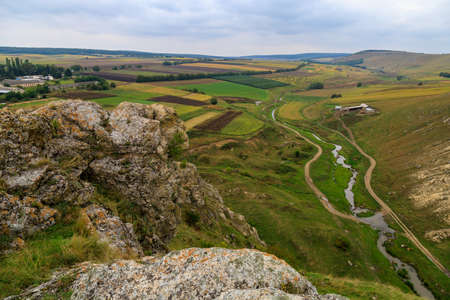Introduction: Unveiling the Cold War in the British Landscape
Britain’s countryside and urban peripheries are quietly marked by the shadows of a turbulent past. The Cold War, a period defined by intense political tension and the looming threat of nuclear conflict, left an indelible mark on the nation’s physical and cultural landscape. From remote Scottish highlands to the rolling fields of southern England, secret bases, hidden bunkers, and abandoned listening posts are silent witnesses to an era when Britain stood on the front line of global uncertainty. Today, these relics—once shrouded in secrecy—have become compelling destinations for those eager to explore the country’s more enigmatic history. Walking Britain’s Cold War landscapes offers not only a unique perspective on military strategy and national resilience but also invites reflection on how these forgotten sites continue to shape our collective memory. As contemporary Britain seeks to understand its past through exploration and preservation, setting out on foot offers an authentic way to engage with this remarkable legacy—one step at a time.
2. Decoding History: Understanding Secret Bases and Bunkers
The landscape of Britain is interwoven with a network of secret bases and hidden bunkers, each constructed with meticulous precision and strategic intent during the Cold War era. These installations were designed as both defensive strongholds and communication hubs, ensuring national survival in the event of nuclear conflict or invasion. Their existence reflects not only the military ingenuity of the period but also the deep-seated anxieties that permeated British society throughout decades marked by geopolitical tension.
Across the UK, these facilities varied in scale, purpose, and secrecy. From vast underground complexes capable of housing government officials to smaller listening posts concealed within rural landscapes, each site was tailored to fulfil a critical role. Below is a summary highlighting some of the most notable examples and their functions:
| Base/Bunker | Location | Strategic Purpose | Notable Features |
|---|---|---|---|
| Burlington Bunker (Corsham) | Wiltshire | Emergency Government Headquarters; continuity of governance | 35-acre subterranean city; 4,000 personnel capacity; own water supply and communications systems |
| Kelvedon Hatch Nuclear Bunker | Essex | Civil Defence Command Centre for London region | Three-storey reinforced structure; radio transmission facilities; decontamination rooms |
| RAF Fylingdales | North Yorkshire Moors | Early warning radar station; missile detection | Iconic ‘golf ball’ radomes (now pyramid structures); 24/7 monitoring capability |
| Hack Green Secret Nuclear Bunker | Cheshire | NATO communications and air defence centre | Two-storey reinforced bunker; extensive radio equipment; blast doors and air filtration systems |
| Anstruther ROC Post | Fife, Scotland | Royal Observer Corps monitoring post; nuclear fallout observation | Small, underground chamber; basic living and monitoring facilities; part of national warning system |
The construction of these sites demanded cutting-edge engineering alongside absolute confidentiality. Many were built deep below ground or cleverly disguised amidst ordinary countryside features, making them nearly invisible to enemy reconnaissance. Their locations were often chosen for strategic proximity to major cities or vital infrastructure, yet far enough afield to reduce risk from direct attacks.
Together, these secret bases and bunkers form an extensive yet largely unseen network that underpinned Britains Cold War readiness. Exploring them on foot today offers a rare window into the operational mindset of a nation perpetually preparing for the worst while hoping for peace—a testament to resilience, resourcefulness, and the unique landscapes shaped by decades of silent vigilance.

3. Mapping the Terrain: Walking Routes to Britain’s Hidden Cold War Sites
Britain’s extensive network of public footpaths and bridleways offers a remarkable opportunity for those wishing to explore the nation’s clandestine Cold War history on foot. Many of these trails weave through landscapes where once-secret installations lie half-forgotten, hidden in plain sight amidst rolling countryside or rugged coastlines. For the intrepid walker, mapping out routes that pass close to disused bunkers, radar stations, and shadowy command centres is a rewarding way to bring history to life while enjoying the best of British scenery.
National Trails with a Secret Past
The South Downs Way, stretching from Winchester to Eastbourne, takes walkers within reach of several former Royal Observer Corps posts—small, concrete structures that once monitored for nuclear fallout. In Yorkshire, the Cleveland Way skirts above Staithes, where remnants of radar installations from the ROTOR programme still stand. Meanwhile, the Ridgeway—often dubbed ‘Britain’s oldest road’—passes close to sites like RAF Greenham Common, where Cold War bunkers have become part of the local heritage.
Local Walks: Uncovering Hidden Histories
Beyond the well-trodden national trails, many local footpaths reveal hidden chapters of Britain’s defensive strategy. In Kent, country walks near Sandwich can lead you past the remains of secret listening stations camouflaged among sand dunes. In Scotland, the Pentland Hills feature old military installations now partially reclaimed by nature but accessible via established walking routes. Even urban explorers will find intrigue: London’s suburbs conceal ROC posts and communications bunkers tucked behind suburban parks and woodland edges.
Planning Your Route Responsibly
While many Cold War sites are visible from public rights of way, some remain on private land or are protected for safety reasons. It is essential to respect all signage and boundaries—trespassing not only risks legal trouble but may also endanger personal safety given the age and condition of some structures. Always use up-to-date Ordnance Survey maps and consult local walking groups for guidance; many offer detailed walk descriptions that highlight points of interest linked to Britain’s secretive past.
By following these carefully mapped routes and observing responsible access practices, walkers can immerse themselves in the atmospheric landscapes that once stood at the heart of Britain’s defence strategy—making each step both a journey through history and a celebration of the country’s remarkable right-to-roam culture.
4. Life Below: Stories and Anecdotes from Britain’s Bunkers
While the imposing facades of Cold War-era bunkers and secret bases are often viewed from the outside, it is the human stories—those of engineers, military personnel, civil servants, and local residents—that truly bring these clandestine sites to life. Drawing on personal accounts, oral histories, and archival materials, we uncover a tapestry of experiences that reflect both the anxiety and ingenuity of the era.
Personal Accounts: Voices from Underground
Many former staff members recall the sense of duty and secrecy that defined daily life beneath ground. For example, Margaret Evans, who worked at RAF Holmpton in Yorkshire, described long shifts monitoring radar screens in an atmosphere she likened to “living inside a time capsule.” The camaraderie among colleagues was strong, with shared routines offering comfort amidst isolation. Others, such as John Taylor—a maintenance engineer at Kelvedon Hatch—spoke of rigorous drills and the ever-present hum of filtration systems meant to keep out nuclear fallout.
Oral Histories: Local Perspectives
Residents living near these installations often speculated about their true purpose. Oral histories collected in rural Norfolk reveal a mix of pride and unease; many locals were aware of increased security but only learned details decades later. Some recount seeing convoys arrive under cover of darkness or hearing rumours about “government men” working on mysterious projects. For younger generations growing up in these areas, abandoned bunkers became places for exploration and imagination—physical remnants of an unseen conflict.
Archival Insights: Building and Operating Secret Sites
The National Archives provide detailed records on construction and operation protocols. The table below summarises key roles within a typical ROC (Royal Observer Corps) bunker:
| Role | Main Responsibilities | Typical Shift Pattern |
|---|---|---|
| Bunker Supervisor | Overall command, security oversight | 24-hour rotation |
| Communications Officer | Liaison with HQ, message handling | 12-hour shifts |
| Technical Engineer | Systems maintenance (power/air) | On-call with regular checks |
| Catering Staff | Meal preparation for crew | Split shifts (day/night) |
Daily Life: Routine Amidst Uncertainty
Despite advanced technology and strict procedures, life inside these bunkers was marked by monotony punctuated by drills or alerts. Meals were simple; entertainment was limited to board games or radio broadcasts. Yet oral testimonies frequently mention humour and resourcefulness—a testament to British resilience under pressure.
A Living Legacy
Today, guided tours and community heritage projects ensure that these stories are not forgotten. By walking in the footsteps of those who served above and below ground, we gain a deeper appreciation for Britain’s Cold War landscapes—not just as relics, but as repositories of collective memory.
5. Preservation and Controversy: The Current Status of Cold War Sites
The fate of Britain’s Cold War sites is a subject that continues to spark lively debate among historians, local authorities, heritage groups, and the general public. As these once-secret bunkers and military installations emerge from the shadows, questions arise regarding their preservation, restoration, or adaptive reuse. Contemporary attitudes towards these relics are shaped by a complex interplay of historical significance, public safety concerns, and competing visions for community development.
Heritage Value versus Practicality
Many advocates argue that Cold War sites are vital historical assets deserving protection and careful stewardship. Organisations such as English Heritage and Subterranea Britannica have campaigned for the listing of key structures, highlighting their role in Britain’s national narrative and collective memory. Proponents see these locations not only as reminders of geopolitical tension but also as testament to the ingenuity and resilience of British society during uncertain times.
Restoration Initiatives
In recent years, select bunkers and command centres have been painstakingly restored and opened to the public as museums or educational centres. Examples include the Hack Green Secret Nuclear Bunker in Cheshire and the Kelvedon Hatch bunker in Essex, both offering immersive glimpses into life under the looming threat of nuclear conflict. These efforts are often community-driven, relying on volunteer support and grants to maintain authenticity while ensuring visitor safety.
Controversies and Community Perspectives
Despite growing interest in preservation, not all Cold War remnants receive universal approval. Detractors question the allocation of resources towards what some perceive as grim relics of fear and paranoia. In certain cases, landowners or developers advocate for demolition or repurposing—transforming abandoned sites into housing estates or commercial venues—citing economic necessity or environmental concerns such as asbestos contamination. This tension reflects broader debates over which chapters of history deserve commemoration, especially when weighed against present-day needs.
A Balancing Act
The future of Britain’s Cold War landscapes ultimately rests on striking a balance between safeguarding historical integrity and accommodating contemporary realities. Public consultations, heritage impact assessments, and innovative reuse projects continue to shape outcomes across the country. As more people lace up their boots to explore these enigmatic sites on foot, the dialogue surrounding their place in Britain’s heritage grows ever more nuanced and essential.
6. Walking with Respect: Guidelines and Ethics for Exploring Cold War Landscapes
Britain’s Cold War heritage is a testament to a tense period in modern history, and exploring these secret bases and hidden bunkers on foot can be both fascinating and sobering. However, responsible exploration is paramount—not only for your own safety but also for the preservation of these sites and respect towards local communities.
Understanding Legal Access and Permissions
Before setting out, it is essential to confirm whether the site you wish to visit is open to the public. Many Cold War structures are located on private land or remain under Ministry of Defence (MoD) ownership. Always check current access rights—trespassing is a criminal offence in the UK. Consult Ordnance Survey maps, local council websites, or heritage organisations such as English Heritage or Subterranea Britannica for up-to-date information regarding public footpaths, byways, and legal restrictions.
Respecting Property and Privacy
If a location is situated near private residences or farmland, adhere strictly to the Countryside Code: leave gates as you find them, avoid disturbing livestock, and do not stray from marked paths. Should you encounter landowners or locals, be courteous—explain your interest if approached, and always comply with their requests.
Prioritising Safety at All Times
Many Cold War sites are derelict or partially collapsed. Never enter structures marked as dangerous or unfit for access. Wear sturdy footwear, bring torches if venturing underground (where permissible), and never explore alone—mobile signal can be unreliable in remote areas. Be mindful of asbestos, sharp debris, or deep drops within old bunkers.
Leave No Trace
Preserve the condition of these historic environments for future generations: do not remove artefacts, graffiti walls, or leave litter behind. Take only photographs and memories.
Complying with Local Customs and Community Sensitivities
Bunkers and bases often lie close to villages where residents may have personal connections to the site’s past—be sensitive when discussing their history. Some locations may serve as memorials; treat them with the solemnity they deserve.
Summary
Exploring Britain’s Cold War landscapes offers a unique perspective on national heritage—but always walk with respect. Stay informed about legal restrictions, put safety first, respect private property, and preserve these evocative sites for others. By following these guidelines and ethics, you contribute positively to the conservation of Britain’s remarkable Cold War legacy.


